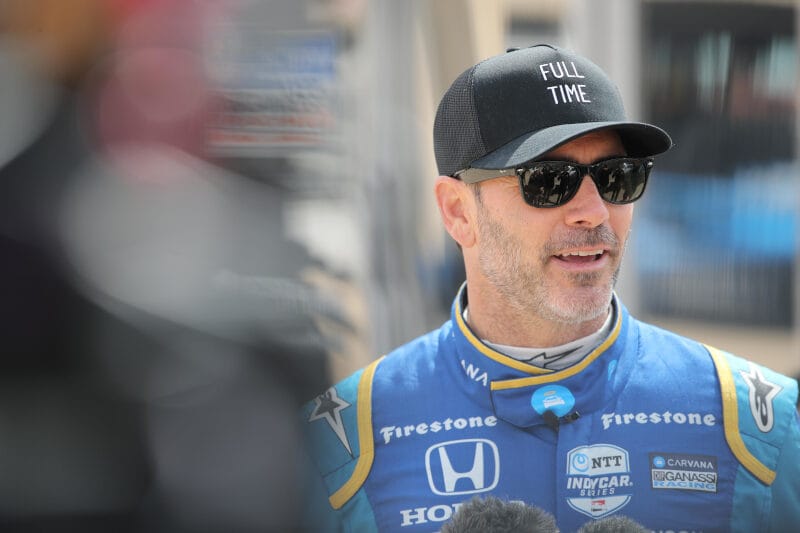Motorsports Racing News & Blog Articles
PREVIEW: 2022 NTT IndyCar Series – Xpel 375
After a thrilling open to the season last month, the NTT IndyCar Series returns to the Lone Star State and the Texas Motor Speedway for the Xpel 375.
This will be the first of five oval races this season, and the first time we will get to see rookies and fan-favorites take to the high banks, as well as the return of some oval specialists. And as always with the 1.5 mile oval, talk of how to make the track more interesting dominates the conversation as the sport looks for alternatives to the PJ1 traction compound that has not helped make the on-track action more exciting. Other alternatives are being explored this weekend.
Will this race be the one to buck the trend of less than stellar performances at Texas? Who will be holding up the six-shooters and wearing the cowboy hat in victory lane? Here’s everything you need to know ahead of the Xpel 375.
WHAT HAPPENED LAST YEAR?
In 2021 IndyCar ran a double header at Texas, the Genesys 300 and Xpel 375. Scott Dixon dominated the Genesys 300, taking the lead from teammate Alex Palou on lap three and immediately stretching out to a lead.
Before the first round of pit stops, the lone caution flag of the race flew on lap 53 for a hard crash involving Josef Newgarden and Sebastien Bourdais. An accordion effect started by Colton Herta forced cars to check up behind him, with Newgarden making contact with the rear of Bourdais’ car, sending him rear-first into the turn two wall and ending his day. Newgarden was given a penalty for avoidable contact in the aftermath of the incident.
Dixon won the race off of pit road and every stop after, leading 206 of the 212 laps in the race. Scott McLaughlin, in his first oval race, finished second behind his fellow New Zealander with Pato O’Ward finishing on the final step of the podium.
 Dixon triumphed in the 2021 Genesys 300, dominating the majority of the race. (Photo Credit: Chris Owens / Penske Entertainment / Courtesy of IndyCar)
Dixon triumphed in the 2021 Genesys 300, dominating the majority of the race. (Photo Credit: Chris Owens / Penske Entertainment / Courtesy of IndyCar)You can read the full race report here.
The next day was the Xpel 375, where O’Ward claimed his first win of the young IndyCar career.
The race started with a massive seven-car pileup coming to green, sending Conor Daly upside down but thankfully ending back on four wheels. Dixon’s dominance from the day prior continued into this race, leading deep into the race. On lap 141, Graham Rahal became the first driver to lead a lap that weekend since Palou at the start of the Genesys 300.
Newgarden became the race leader after successfully performing the overcut on his final pit stop, followed through the lap traffic by O’Ward. With 24 laps to go, O’Ward dove to the inside of Newgarden heading into turn three, resulting in O’Ward’s first win of his career. This win sealed O’Ward his Formula 1 test with McLaren Racing at the Yas Marina Circuit in Abu Dhabi in December 2021.
 O’Ward celebrating his first IndyCar win at the 2021 Xpel 375. (Photo Credit: Chris Owens / Penske Entertainment / Courtesy of IndyCar)
O’Ward celebrating his first IndyCar win at the 2021 Xpel 375. (Photo Credit: Chris Owens / Penske Entertainment / Courtesy of IndyCar)You can read the full race report here.
WHAT TO LOOK OUT FOR THIS WEEKEND?
Prior to winning his first race, McLaughlin’s best finish of his career came in the Genesys 300 last year in the runner-up spot. This could be a fantastic chance for the 28-year-old to capitalize on his early season momentum and turn that silver medal into a gold, win his first oval race, and go two for two to start the season.
This will be the first oval competition for rookies like Kyle Kirkwood, Christian Lundgaard, Devlin DeFrancesco, David Malukas and Callum Ilott. This is also going to be the oval debut for Jimmie Johnson and while not his first oval, Romain Grosjean‘s first race at Texas. At a rookie oval test earlier this month, Kirkwood topped the charts at the test followed by Ilott and Grosjean, who had the fastest lap without aerodynamic tow.
Johnson tested at Texas in August 2021, and holds the record for most wins at the track in NASCAR Cup Series history with seven. Many have anticipated this to be the 46-year-old’s best chance to win in IndyCar, and his performance over the weekend will be one to watch.
 Jimmie Johnson holds the record for most wins at Texas Motor Speedway in the NASCAR Cup Series, this will be his first oval start in the NTT IndyCar Series. (Photo Credit: Chris Owens / Penske Entertainment / Courtesy of IndyCar)
Jimmie Johnson holds the record for most wins at Texas Motor Speedway in the NASCAR Cup Series, this will be his first oval start in the NTT IndyCar Series. (Photo Credit: Chris Owens / Penske Entertainment / Courtesy of IndyCar)Speaking of track records, Helio Castroneves used to hold the record in IndyCar for most wins at Texas, and this Sunday will be his first race at the track since 2017. Since then, Dixon has won three times and snatched the title from the Brazilian with five wins total. Castroneves, now back with Meyer Shank Racing, will be looking to put one hand back on that record with a win this weekend.
J.R. Hildebrand and Ed Carpenter make their return to the grid this weekend as well. Hildebrand and A.J. Foyt Enterprises announced on 11 March that the 34-year-old-American will run all ovals including the Indianapolis 500 for the team, piloting the 11 car in place of Tatiana Calderon, who is on a road and street course schedule. Carpenter, who won at Texas in 2014, returns for his own team Ed Carpenter Racing piloting the No. 33 car with Conor Daly full-time in the 20 car.
The most prominent talking point surrounding Texas, as has been the case in recent years, has been the use of PJ1 traction compound. First put on the track in 2019 to increase grip for NASCAR, the compound does not create the same effect with IndyCar. The lighter vehicle and harder compound tyre makes the areas covered by the substance very slippery, thus drivers avoid it and stick to the bottom lane, turning Texas into a one lane track. To make matters worse, marbles from worn tyres get collected up in that part of the track which makes it even more of a danger zone.
As reported by RACER, IndyCar is exploring multiple options to help increase grip in the top lanes. While the track has made efforts to scrub it from the surface, more work needs to be done.
The first option is using a “steel mesh device” over the PJ1-affected areas to create consistent grip to the bottom lane. There is also the possibility of creating the same effect with a chemical wash.
 The dark PJ1 substance can be seen here above Scott McLaughlin’s Chevrolet. (Photo Credit: Chris Jones / Penske Entertainment / Courtesy of IndyCar)
The dark PJ1 substance can be seen here above Scott McLaughlin’s Chevrolet. (Photo Credit: Chris Jones / Penske Entertainment / Courtesy of IndyCar)The third option, and the one that is “most likely” according to RACER’s Marshall Pruett, is for time to be added to one of two hour-long practice sessions on Saturday to allow drivers to progressively gather speed and utilize all 27 cars to lay down rubber along the second lane. RACER stated that IndyCar is looking to add 30 minutes to one of those Saturday sessions to attempt this.
If IndyCar is able to successfully create another lane that drivers can utilize without fear of crashing, that will completely revitalize the track and turn this race on it’s head.
WEEKEND SCHEDULE
Saturday 19 March
1100 EST / 1500 EST – Practice 1
1400 EST / 1800 GMT – Qualifying
1700 EST / 2100 GMT – Final Practice
Sunday 20 March
1230 EST / 1630 GMT – Race
WHERE CAN I WATCH?
Coverage in the UK for qualifying and the race will be provided by Sky Sports F1.
In the United States, coverage for the race will be on NBC. Practice and Qualifying will be shown live on the Peacock streaming service.
HOW CAN I KEEP UP WITH ALL THE ACTION?
You can follow all the all the action here at The Checkered Flag. We will be providing coverage of the practice, qualifying, and race sessions.
You can also follow IndyCar on Twitter (@Indycar) for live updates during the sessions.
Copyright
© The Checkered Flag
